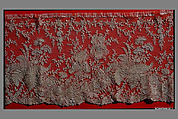Flounce
Manufactory Verdé, Delisle & Cie.
Not on view
Trimmings of real handmade lace were very expensive prized possessions, and a piece as fine as this may never have been used. Queen Victoria had tried unsuccessfully to revive interest in Honiton laces, handmade in Devon, with the order for her magnificent wedding flounce, but the craft was already too far gone in the face of competition from machine production. After 1861, she wore the flounce with her mourning dress for the rest of her life.
As a result of the disappearance of lacemaking by hand on a commercial scale, collecting antique handmade lace became very popular in the late nineteenth century. Pieces such as collars and flounces were purchased to be worn. Exhibition pieces continued to be made, mostly in the form of handkerchief borders, until at least 1900. The Museum owns a number of fine examples.
Due to rights restrictions, this image cannot be enlarged, viewed at full screen, or downloaded.

